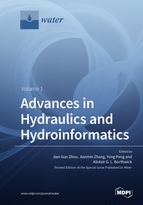Advances in Hydraulics and Hydroinformatics
A special issue of Water (ISSN 2073-4441). This special issue belongs to the section "Hydraulics and Hydrodynamics".
Deadline for manuscript submissions: closed (1 March 2019) | Viewed by 168039
Special Issue Editors
Interests: mathematical model; numerical methods; lattice Boltzmann method; sediment transport; mass transport; computational hydrodynamics
Special Issues, Collections and Topics in MDPI journals
Interests: engineering hydraulics; flood discharge; energy dissipation; model experiments; numerical simulation of turbulence; two-phase flows
Interests: shallow water equations; suspended load; morphological changes; stormwater pond
Special Issue Information
Dear Colleagues,
Great progress has been made in research on hydraulics and hydroinformatics over the past few decades, which include theoretical, experimental and numerical studies, generating new understanding and knowledge. This undoubtedly accelerates the applications of research outcomes in solving challenging problems for optimizing design and improving relevant management of flow problems in engineering. For example, new formulations in the treatment of bed friction in the shallow water model for overland flow due to rainfall, and coupled 1D–2D hydrodynamic inundation model for sewer overflow may shed light on the forecast and mitigation of flooding under climate change. In order to meet the requirements of speedy knowledge transfer to resolving engineering problems, this Special Issue aims to report the on-going research in hydraulics and hydroinformatics as well as their novel applications in practical engineering. All original contributions in the following areas will be considered for publication. This includes new research on hydraulics and hydroinformatics and their latest applications without being limited to the following listed topics, e.g., urban floods, sediment transport dynamics, environmental hydraulics, subsurface flows, hydropower station hydraulics, ecological hydraulics, ice hydraulics, numerical simulation of hydraulics, multiphysics and multiscale methods, new numerical schemes, high-performance computing, remote sensing, geography information systems, global positioning systems.
Dr. JianGuo Zhou
Prof. Dr. Jianmin Zhang
Assoc. Prof. Dr. Yong Peng
Prof. Dr. Alistair Borthwick
Guest Editors
Manuscript Submission Information
Manuscripts should be submitted online at www.mdpi.com by registering and logging in to this website. Once you are registered, click here to go to the submission form. Manuscripts can be submitted until the deadline. All submissions that pass pre-check are peer-reviewed. Accepted papers will be published continuously in the journal (as soon as accepted) and will be listed together on the special issue website. Research articles, review articles as well as short communications are invited. For planned papers, a title and short abstract (about 100 words) can be sent to the Editorial Office for announcement on this website.
Submitted manuscripts should not have been published previously, nor be under consideration for publication elsewhere (except conference proceedings papers). All manuscripts are thoroughly refereed through a single-blind peer-review process. A guide for authors and other relevant information for submission of manuscripts is available on the Instructions for Authors page. Water is an international peer-reviewed open access semimonthly journal published by MDPI.
Please visit the Instructions for Authors page before submitting a manuscript. The Article Processing Charge (APC) for publication in this open access journal is 2600 CHF (Swiss Francs). Submitted papers should be well formatted and use good English. Authors may use MDPI's English editing service prior to publication or during author revisions.
Keywords
- Engineering hydraulics
- Urban floods
- Sediment transport dynamics
- Environmental hydraulics
- Remote sensing
- Geography information systems
- Global positioning systems
- Multiphysics and multiscale methods
- Experiments in hydraulics









